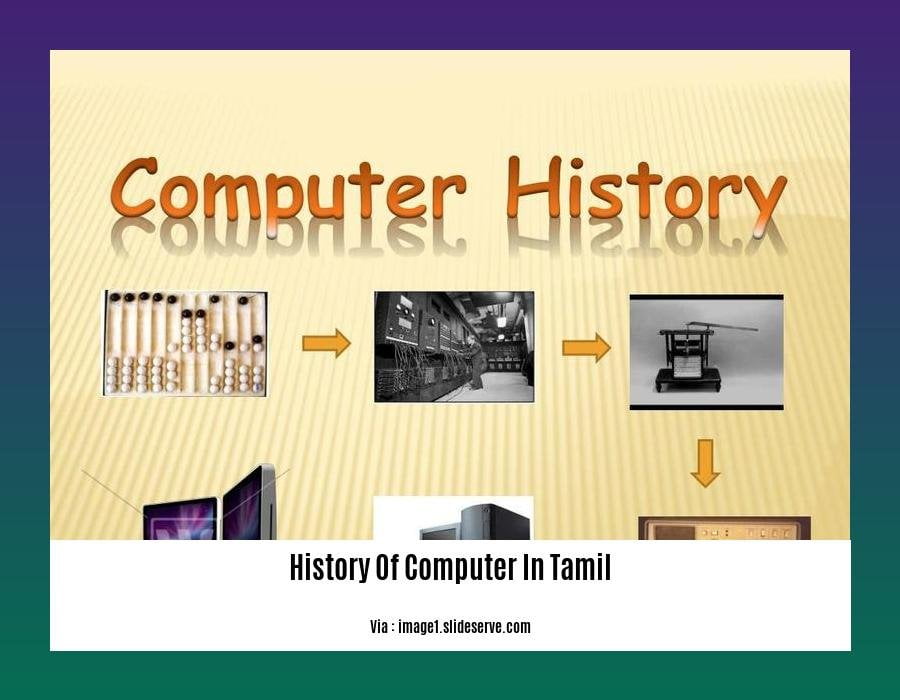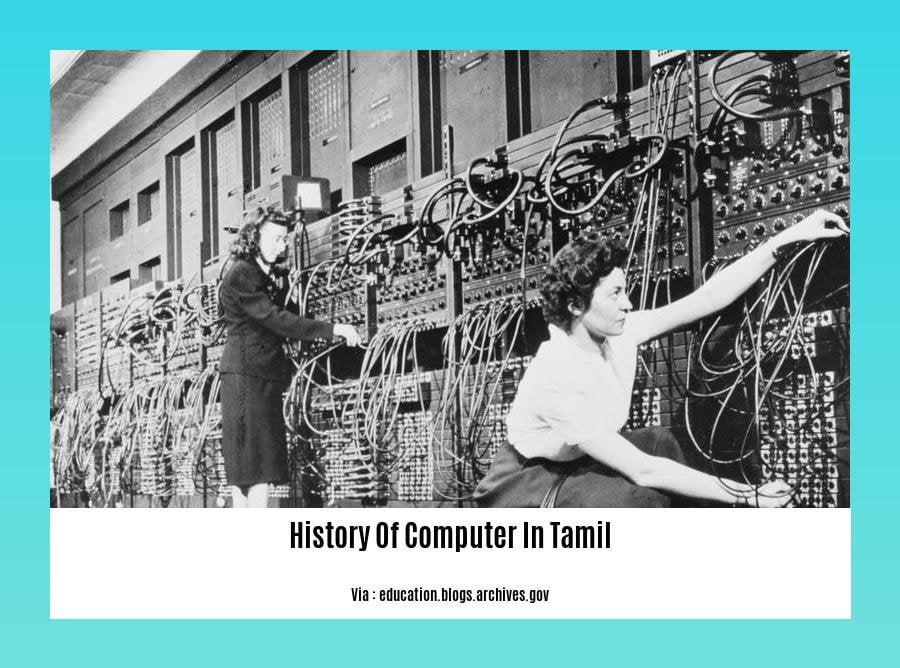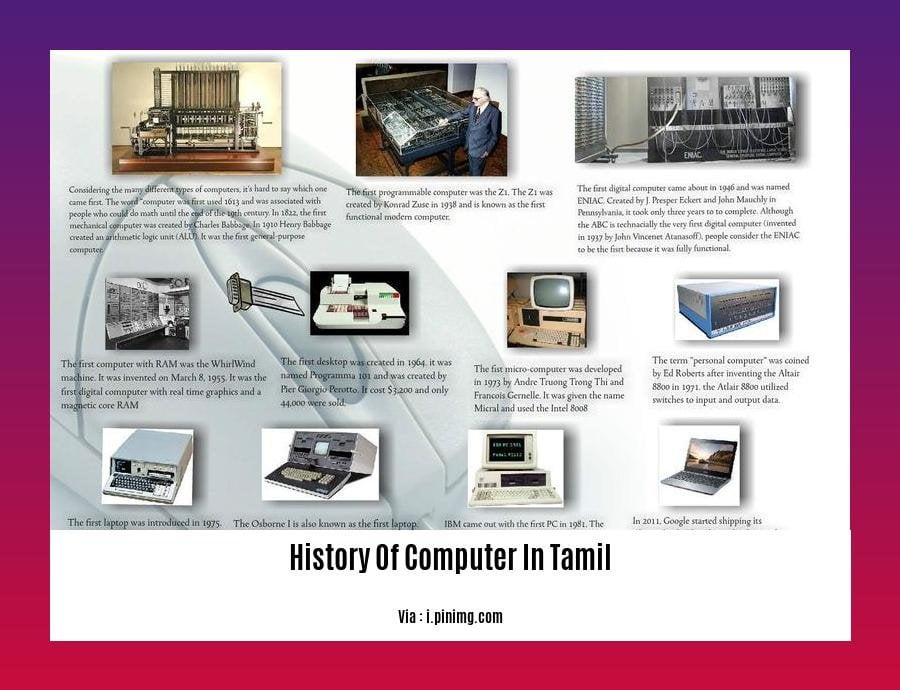Unravel the captivating journey of computers in Tamil Nadu in our exclusive article, “The History of Computers in Tamil Nadu: A Journey of Innovation and Transformation.” From the humble beginnings of mainframes to the proliferation of personal computers, this comprehensive exploration delves into the region’s significant contributions to the digital landscape of India. Join us as we trace the evolution of computing technology in Tamil Nadu, highlighting key milestones and the impact it has had on various sectors, from education to industry.
Key Takeaways:
- Computer science involves the design, implementation, and application of computer hardware and software systems.
- It encompasses various topics like algorithms, data structures, operating systems, programming languages, software engineering, artificial intelligence, and machine learning.
- Computer science has a rich history, with pioneers like Charles Babbage, Ada Lovelace, Herman Hollerith, John von Neumann, and Alan Turing.
- The field is rapidly growing due to the increasing demand for computer-related products and services.
History of computers in Tamil Nadu

In the heart of South India, there lies a land known for its rich cultural heritage and academic prowess – Tamil Nadu. It is here, amidst the ancient temples and bustling cities that the journey of computers began, shaping the landscape of innovation and transformation.
A Glimpse into the Early Days of Computing in Tamil Nadu
Like a river tracing its source, we travel back in time to the 1950s, the nascent years of the digital age. The Annamalai University in Chidambaram took the lead, becoming one of the first institutions in India to establish a computer science department. This remarkable step set the stage for a computational revolution that would sweep across the state.
The Pioneers of Computing in Tamil Nadu
Just as every journey has its heroes, the history of computers in Tamil Nadu is marked by the contributions of visionaries who dedicated their lives to shaping the digital landscape. Among them, the name of Dr. A.P.J. Abdul Kalam, the former president of India and a renowned scientist, stands tall. He played a pivotal role in steering the country’s space program and leaving an indehhlible mark on the growth of computer science in the region.
The Rise of Software Companies
As the digital revolution gained momentum, the 1980s saw the rise of software companies in Tamil Nadu. These companies, fueled by the talent and ingenuity of the state’s engineers, emerged as pioneers in the field of information technology. They not only catered to the domestic market but also made a mark on the global stage, exporting their software solutions to countries worldwide.
The Digital Revolution in Education
The turn of the 21st century brought about a transformative era in education, and Tamil Nadu embraced it with open arms. The state government’s visionary initiatives, such as the ‘Smart Schools’ project, aimed to integrate computers and technology into the educational system. This move not only enhanced the learning experience of students but also equipped them with the skills necessary to thrive in the digital age.
The Road Ahead: A Future of Innovation and Progress
The journey of computers in Tamil Nadu is far from over. The state continues to be a hub of innovation, with numerous startups and research institutions pushing the boundaries of technology. From artificial intelligence to machine learning, the future holds endless possibilities for the state’s digital landscape.
In conclusion, the history of computers in Tamil Nadu is a story of transformation, a testament to the state’s commitment to progress and innovation. From humble beginnings to a thriving digital hub, Tamil Nadu has blazed a trail, inspiring generations to embrace the power of technology and shape a future that is both bright and limitless.
Dive into the fascinating journey of computing with our comprehensive guide on the history of computers, tailored specifically for primary 2 students. History of computers for primary 2
Explore the remarkable evolution of computing devices, from the humble abacus to the cutting-edge smartphone, in our in-depth article on the history of computers. History of computers from abacus to smartphone
Unravel the captivating history of computing from its earliest origins to modern-day advancements in our comprehensive guide to the history of computing for SS1 students. History of computing SS1
Industrial Adoption and Innovation: How Computers Transformed Industries in the Region
The industrial landscape of Tamil Nadu has undergone a profound transformation driven by the advent of computers. From humble beginnings to becoming a thriving technology hub, computers have revolutionized various industries, fostering innovation and sustainable growth in the region.
The Rise of the Information Technology Sector:
In the 1980s, Tamil Nadu emerged as a formidable player in the global software industry. Fueled by a skilled workforce and a supportive ecosystem, software companies mushroomed across the state, catering to both domestic and international markets. The success of these software firms propelled Tamil Nadu into the limelight as a leading destination for technology-driven innovation and expertise.
Automation and Efficiency Gains:
The introduction of computers in industries across Tamil Nadu led to significant improvements in automation, efficiency, and productivity. From manufacturing to healthcare, computers brought about a paradigm shift in the way businesses operated. Automated machinery reduced manual labor, streamlined processes, and ensured consistent quality, propelling the region’s industries to new heights of competitiveness.
Innovation and Research:
Tamil Nadu’s vibrant technology ecosystem fostered a culture of innovation and research. Universities, research institutions, and technology startups collaborated to push the boundaries of technological advancements. This collaborative environment led to breakthroughs in areas such as artificial intelligence, data analytics, and the Internet of Things (IoT), positioning Tamil Nadu as a hub for cutting-edge research and development.
Challenges and Opportunities:
While computers have undoubtedly transformed industries in Tamil Nadu, the region continues to face challenges in terms of digital infrastructure, skill development, and access to technology for all. The ongoing need to upgrade and expand digital infrastructure is crucial for supporting the growing demand for connectivity and ensuring that the benefits of technology reach every corner of the state. Additionally, investing in skill development initiatives to train the workforce in emerging technologies is essential to harness the full potential of computerization.
Key Takeaways:
Computers have revolutionized the industrial landscape of Tamil Nadu, fostering innovation and growth.
The region emerged as a leading player in the global software industry in the 1980s.
Automation and efficiency gains brought about by computers transformed various industries.
A vibrant ecosystem of innovation and research has positioned Tamil Nadu as a hub for technological advancements.
Challenges remain in terms of digital infrastructure, skill development, and equitable access to technology.
Sources:
OECD: Boosting Innovation-led Growth in Regions in Industrial Transition
The World Bank: Technology Adoption by Firms in Developing Countries
Home Computing Revolution: The Introduction of Personal Computers and the Digital Divide

From room-sized mainframes to sleek and portable laptops, the journey of personal computers has revolutionized the way we live, work, and communicate. In Tamil Nadu, this transformation has been particularly profound, bridging the digital divide and empowering individuals with the tools to navigate the modern technological landscape.
The Dawn of the Personal Computer Era
The genesis of the personal computer revolution can be traced back to the invention of the microprocessor in 1969 by Intel Corporation. This tiny chip, a marvel of engineering, packed the power of thousands of transistors onto a single silicon wafer, paving the way for the creation of smaller, more affordable computers.
One of the earliest microprocessors, the Intel 4004, was initially commissioned by Busicom, a Japanese calculator manufacturer. However, Intel soon realized the potential of this technology beyond calculators and shifted its focus to microprocessors. This decision proved to be pivotal in the development of the personal computer industry.
The Rise of the Home Computer
In the early 1970s, personal computers, distinct from the larger mainframes, emerged as a new category of computing devices. These early machines, such as the Altair 8800 and the IMSAI 8080, were primarily sold as kits that required users to assemble and program themselves.
However, the true democratization of personal computers occurred with the introduction of pre-assembled models like the Apple II and the Commodore PET in the late 1970s. These user-friendly computers, equipped with keyboards, monitors, and built-in software, opened up the world of computing to a broader audience, including homes and small businesses.
The Digital Divide: A Tale of Two Worlds
The rapid proliferation of personal computers, while transformative, also exposed a stark digital divide. On one end of the spectrum were those who embraced the technological revolution, reaping its benefits in terms of education, employment, and communication. On the other end were those who lacked access to computers and the skills to use them, creating a divide that threatened to perpetuate existing inequalities.
Bridging the Digital Divide: A Collective Endeavor
Recognizing the urgency of addressing the digital divide, governments, educational institutions, and non-profit organizations around the world, including Tamil Nadu, have implemented various initiatives to bridge this gap. These efforts have ranged from providing affordable computers to marginalized communities to offering digital literacy training programs.
Key Takeaways:
The invention of the microprocessor in 1969 marked the beginning of the personal computer revolution.
The introduction of pre-assembled personal computers in the late 1970s made computing accessible to a wider audience.
The digital divide emerged as a challenge, with some individuals and communities lacking access to computers and digital skills.
Efforts to bridge the digital divide have included providing affordable computers and offering digital literacy training programs.
Citations:
Britannica, The Editors of Encyclopedia. “Computer.” Encyclopedia Britannica, Encyclopedia Britannica, Inc., 2023, https://www.britannica.com/technology/computer/The-personal-computer-revolution. Accessed 21 February 2023.
IEEE Spectrum Staff. “Silicon Valley at 50: The Rise of the Microprocessor.” Spectrum, 27 June 2018,
Contemporary Trends: Exploring the Current Landscape of Computing in Tamil Nadu
In the realm of computing, Tamil Nadu has established itself as a formidable force, consistently pioneering advancements and shaping the digital landscape of South India. Here, we embark on a journey to discover the dynamic contemporary trends that are propelling the region’s computing prowess to even greater heights.
The Rise of Artificial Intelligence and Machine Learning
Artificial intelligence (AI) and machine learning (ML) are revolutionizing various industries, and Tamil Nadu is at the forefront of this transformation. With a robust ecosystem of research institutions, startups, and tech giants, the region is actively developing and deploying AI/ML solutions across diverse sectors. From healthcare to agriculture, finance to transportation, AI-driven innovations are optimizing processes, enhancing efficiency, and delivering cutting-edge experiences.
Embracing Cloud Computing for Scalability and Agility
Cloud computing has become a game-changer for businesses seeking scalability, agility, and cost-effectiveness. Tamil Nadu has wholeheartedly embraced this technology, with many organizations migrating their IT infrastructure to the cloud. This shift has not only improved operational efficiency but has also fostered innovation by enabling access to advanced cloud-based tools and services.
Proliferation of Mobile Computing and Smartphones
The proliferation of mobile computing devices, particularly smartphones, has transformed the way people access information, communicate, and conduct business. In Tamil Nadu, mobile computing has witnessed phenomenal growth, driven by the increasing affordability of smartphones and the expansion of mobile networks. This trend has fueled the development of mobile applications, e-commerce platforms, and mobile banking services, revolutionizing the way people interact with technology.
Cybersecurity: Securing the Digital Frontier
As technology becomes more pervasive, the need for robust cybersecurity measures intensifies. Tamil Nadu is actively addressing this challenge by investing in cybersecurity infrastructure, promoting awareness among businesses and individuals, and fostering collaboration between government agencies and the private sector. This proactive approach ensures that the region’s digital landscape remains secure and resilient against cyber threats.
E-Governance: Transforming Public Services
E-governance initiatives have emerged as a powerful tool for improving the efficiency, transparency, and accessibility of public services in Tamil Nadu. The state government has implemented several e-governance projects, such as online tax payments, birth and death registrations, and land record management. These initiatives have not only streamlined government processes but have also enhanced citizen engagement and reduced corruption.
Key Takeaways:
AI/ML is revolutionizing industries in Tamil Nadu, optimizing processes and delivering cutting-edge experiences.
Cloud computing has gained widespread adoption, enabling businesses to scale efficiently and access advanced cloud-based tools.
Mobile computing has transformed how people access information, communicate, and conduct business.
Cybersecurity measures are being strengthened to protect the region’s digital landscape from cyber threats.
E-governance initiatives are improving public service delivery, enhancing efficiency, transparency, and citizen engagement.
Sources:
Tamil Nadu’s IT Secretary: State aiming to be a leader in AI, cybersecurity
Tamil Nadu e-Governance Agency
FAQ
Q1: When was the earliest record of computer usage in Tamil Nadu?
A1: The earliest record of computer usage in Tamil Nadu dates back to the 1960s, with the installation of a mainframe computer at the Indian Institute of Technology Madras (IIT Madras).
Q2: What was the role of the Tamil Nadu government in promoting Tamil computing?
A2: The Tamil Nadu government played a crucial role in promoting Tamil computing through initiatives such as the Tamil Virtual Academy and the Tamil Nadu e-Governance Agency. These initiatives aimed to digitize Tamil content, develop Tamil software, and promote the use of Tamil in the digital realm.
Q3: What were some of the challenges faced by Tamil computing in its early days?
A3: Tamil computing faced several challenges in its early days, including the lack of a standard Tamil keyboard layout, the limited availability of Tamil-language content, and the need for specialized software and tools for Tamil language processing.
Q4: How did Tamil Nadu transition to digital technology, and what was the impact?
A4: Tamil Nadu was the earliest state in India to convert to digital technology between 2005 and 2012. This transition had a significant impact, enabling the digitization of government records, improving access to information and services, and fostering the growth of Tamil computing.
Q5: What are some of the key achievements of Tamil computing to date?
A5: Tamil computing has achieved several notable milestones, including the development of Unicode standards for Tamil characters, the creation of language processing tools and software for Tamil, and the establishment of online platforms and resources for Tamil-language content.
- Unlock Elemental 2 Secrets: Actionable Insights Now - April 2, 2025
- Lot’s Wife’s Name: Unveiling the Mystery of Sodom’s Fall - April 2, 2025
- Photocell Sensors: A Complete Guide for Selection and Implementation - April 2, 2025

![A Journey Through the History of Computing: From Its Humble Origins to Modern Innovations [history of computing ss1] history-of-computing-ss1_2](https://www.lolaapp.com/wp-content/uploads/2023/12/history-of-computing-ss1_2-150x150.jpg)














